3D Cadastral Database Systems—A Systematic Literature Review
Abstract
1. Introduction
2. Research Methodology
2.1. Research Questions
- RQ1: How are 3D cadastral data stored and managed currently?
- RQ2: What are the main technical limitations and challenges involved in storing 3D cadastral data? What are the strengths and weaknesses of the current practices?
- RQ3: How can 3D cadastral databases be developed in future with a focus on the research gaps and related directions?
2.2. Search and Selection Process
- Designing a database for 3D cadastral data;
- Using databases as part of their research;
- Identifying the criteria and challenges and need for developing a database.
| Inclusion criteria |
|
| Exclusion criteria |
|
2.3. Data Analysis
3. Current Approaches to 3D Cadastral Data Storage
3.1. Without Database Implementation
3.2. File-Based Approaches
3.3. Using Databases
3.4. Designing Databases/Physical Implementation
- Their primary focus was designing a database for 3D cadastre or 3D land administration.
- They implemented a 3D database or cadastral system, particularly designing geodatabases or implementing physical data models.
4. Discussion, Challenges, and Knowledge Gaps
- Supporting appropriate data type for 3D spatial data without changing or losing information during data migration or insertion;
- Modelling regular and irregular surfaces;
- Storing boundaries with complex structures such as oblique and curved ones;
- Modelling moving objects such as coastline and river boundaries;
- Supporting temporal aspects, time intervals, and versioning;
- Modelling multidimensional objects;
- Covering topological, geometrical, and directional relations as well as metric and Boolean operators;
- Providing 3D spatial functions;
- Handling large datasets;
- Ensuring data quality and validation;
- Defining spatial indexes;
- Optimizing storing and retrieving.
5. Conclusions
Author Contributions
Funding
Data Availability Statement
Conflicts of Interest
References
- Stoter, J.E.; van Oosterom, P. 3D Cadastre in An International Context: Legal, Organizational, and Technological Aspects; CRC Press: Boca Raton, FL, USA, 2006. [Google Scholar]
- Lemmen, C.; van Oosterom, P.J.; Kara, A.; Kalogianni, E.; Shnaidman, A.; Indrajit, A.; Alattas, A. The scope of LADM revision is shaping-up. In Proceedings of the 8th Land Administration Domain Model Workshop, Kuala Lumpur, Malaysia, 1–3 October 2019. [Google Scholar]
- Saeidian, B.; Rajabifard, A.; Atazadeh, B.; Kalantari, M. Modelling underground cadastral survey data in CityGML. Trans. GIS 2023, 27, 1724–1747. [Google Scholar] [CrossRef]
- Atazadeh, B.; Halalkhor Mirkalaei, L.; Olfat, H.; Rajabifard, A.; Shojaei, D. Integration of cadastral survey data into building information models. Geo-Spat. Inf. Sci. 2021, 24, 387–402. [Google Scholar] [CrossRef]
- Salleh, S.; Ujang, U.; Azri, S. 3D topological support in spatial databases: An overview. Int. Arch. Photogramm. Remote Sens. Spat. Inf. Sci. 2021, 46, 473–478. [Google Scholar] [CrossRef]
- Thompson, R.; van Oosterom, P. Bi-temporal foundation for LADM v2: Fusing event and state based modelling of Land administration data 2D and 3D. Land Use Policy 2021, 102, 105246. [Google Scholar] [CrossRef]
- Van Oosterom, P.; Ploeger, H.; Stoter, J.; Thompson, R.; Lemmen, C. Aspects of a 4D Cadastre: A First Exploration. In Proceedings of the FIG Congress, Shaping the Change, Munich, Germany, 8–13 October 2006; Available online: https://www.researchgate.net/publication/252548375_Aspects_of_a_4D_Cadastre_A_First_Exploration (accessed on 15 October 2023).
- Döner, F.; Thompson, R.; Stoter, J.; Lemmen, C.; Ploeger, H.; van Oosterom, P.; Zlatanova, S. 4D cadastres: First analysis of legal, organizational, and technical impact—With a case study on utility networks. Land Use Policy 2010, 27, 1068–1081. [Google Scholar] [CrossRef]
- Döner, F.; Thompson, R.; Stoter, J.; Lemmen, C.; Ploeger, H.; van Oosterom, P.; Zlatanova, S. Solutions for 4D cadastre—with a case study on utility networks. Int. J. Geogr. Inf. Sci. 2011, 25, 1173–1189. [Google Scholar] [CrossRef]
- Van Oosterom, P.; Stoter, J. 5D data modelling: Full integration of 2D/3D space, time and scale dimensions. In Proceedings of the Geographic Information Science: 6th International Conference, GIScience 2010, Zurich, Switzerland, 14–17 September 2010; Proceedings 6. Springer: Berlin/Heidelberg, Germany, 2010; pp. 310–324. [Google Scholar]
- Thompson, R.; van Oosterom, P.; Karki, S. Towards an implementable data schema for 4D/5D cadastre including bi-temporal support. In Proceedings of the FIG Working Week 2019, Geospatial Information for a Smarter Life and Environmental Resilience, Hanoi, Vietnam, 22–26 April 2019. [Google Scholar]
- van Oosterom, P.; Erba, D.A.; Aien, A.; Grant, D.; Kalantari, M.; Karki, S.; Shojaei, D.; Thompson, R.; Muggenhuber, G.; Navratil, G. Best Practices 3D Cadastres: Extended Version; van Oosterom, P., Ed.; International Federation of Surveyors (FIG): Copenhagen, Denmark, 2018. [Google Scholar]
- Kara, A.; Lemmen, C.; van Oosterom, P.; Kalogianni, E.; Alattas, A.; Indrajit, A. Design of the new structure and capabilities of LADM edition II including 3D aspects. Land Use Policy 2024, 137, 107003. [Google Scholar] [CrossRef]
- Kara, A.; Lemmen, C.; Kalogianni, E.; van Oosterom, P. Requirements Based Design of the LADM Edition II. In Proceedings of the 11th International FIG Land Administration Domain Model/3D Land Administration Workshop, Gävle, Sweden, 1–13 October 2023. [Google Scholar]
- Olfat, H.; Atazadeh, B.; Badiee, F.; Chen, Y.; Shojaei, D.; Rajabifard, A. A Proposal for Streamlining 3D Digital Cadastral Data Lifecycle. Land 2021, 10, 642. [Google Scholar] [CrossRef]
- Van Oosterom, P.; Meijers, M.; Verbree, E.; Liu, H.; Tijssen, T. Towards a relational database Space Filling Curve (SFC) interface specification for managing nD-PointClouds. In Proceedings of the Münchner GI-Runde, München, Germany, 14–15 March 2019. [Google Scholar]
- Watt, A.; Eng, N. Database Design, 2nd ed.; BCcampus: Victoria, BC, Canada, 2014. [Google Scholar]
- Kalogianni, E.; van Oosterom, P.; Dimopoulou, E.; Lemmen, C. 3D land administration: A review and a future vision in the context of the spatial development lifecycle. ISPRS Int. J. Geo-Inf. 2020, 9, 107. [Google Scholar] [CrossRef]
- Mamoulis, N. Spatial Data Management; Morgan & Claypool: San Rafael, CA, USA, 2011. [Google Scholar]
- Tekavec, J.; Čeh, M.; Lisec, A. Indoor space as the basis for modelling of buildings in a 3D Cadastre. Surv. Rev. 2021, 53, 464–475. [Google Scholar] [CrossRef]
- Zlatanova, S.; Stoter, J. The role of DBMS in the new generation GIS architecture. Front. Geogr. Inf. Technol. 2006, 155–180. [Google Scholar]
- Kalogianni, E.; Dimopoulou, E.; Thompson, R.J.; Lemmen, C.; Ying, S.; van Oosterom, P. Development of 3D spatial profiles to support the full lifecycle of 3D objects. Land Use Policy 2020, 98, 104177. [Google Scholar] [CrossRef]
- Masri, T.; Paudyal, D.R. Development Of 3d Cadastre In New South Wales Through E-Plan Lodgement. ISPRS Ann. Photogramm. Remote Sens. Spat. Inf. Sci. 2021, 4, 139–146. [Google Scholar] [CrossRef]
- Coronel, C.; Morris, S. Database Systems: Design, Implementation, & Management, 13th ed.; Cengage Learning: Boston, MA, USA, 2017. [Google Scholar]
- Bar-Maor, A.; Smyth, K. ArcGIS & LADM (ISO 19152): From Conceptual to Implementation. In Proceedings of the FIG Congress 2022, Volunteering for the future—Geospatial excellence for a better living, Warsaw, Poland, 11–15 September 2022; International Federation of Surveyors (FIG): Copenhagen, Denmark. [Google Scholar]
- Shahidinejad, J.; Kalantari, M.; Rajabifard, A. Challenges and Steps Toward Implementing 3D Cadastral Database—Physical Data Model of LADM. In Proceedings of the 18th International 3D GeoInfo Conference, Munich, Germany, 13–14 October 2023. [Google Scholar]
- Alattas, A.; Van Oosterom, P.; Zlatanova, S. Deriving the technical model for the indoor navigation prototype based on the integration of IndoorGML and LADM conceptual model. In Proceedings of the 7th International FIG Workshop on the Land Administration Domain Model, Zagreb, Croatia, 11–13 April 2018; pp. 12–13. [Google Scholar]
- Alattas, A.; van Oosterom, P.; Zlatanova, S.; Diakité, A.A.; Yan, J. Developing a database for the LADM-IndoorGML model. In Proceedings of the 6th International FIG Workshop on 3D Cadastres, Delft, The Netherlands, 2–4 October 2018; International Federation of Surveyors (FIG): Copenhagen, Denmark; pp. 261–277. [Google Scholar]
- Stoter, J.E. 3D Cadastre; TU Delft: Delft, The Netherlands, 2004. [Google Scholar]
- Barzegar, M.; Rajabifard, A.; Kalantari, M.; Atazadeh, B. An IFC-based database schema for mapping BIM data into a 3D spatially enabled land administration database. Int. J. Digit. Earth 2021, 14, 736–765. [Google Scholar] [CrossRef]
- Barzegar, M.; Rajabifard, A.; Kalantari, M.; Atazadeh, B. A framework for spatial analysis in 3D urban land administration–A case study for Victoria, Australia. Land Use Policy 2021, 111, 105766. [Google Scholar] [CrossRef]
- Li, W.; Zlatanova, S.; Diakite, A.A.; Aleksandrov, M.; Yan, J. Towards integrating heterogeneous data: A spatial DBMS solution from a CRC-LCL project in Australia. ISPRS Int. J. Geo-Inf. 2020, 9, 63. [Google Scholar] [CrossRef]
- Kitchenham, B.; Brereton, O.P.; Budgen, D.; Turner, M.; Bailey, J.; Linkman, S. Systematic literature reviews in software engineering–a systematic literature review. Inf. Softw. Technol. 2009, 51, 7–15. [Google Scholar] [CrossRef]
- Kitchenham, B.; Charters, S. Guidelines for performing systematic literature reviews in software engineering version 2.3. Engineering 2007, 45, 1051. [Google Scholar]
- Wohlin, C. Guidelines for snowballing in systematic literature studies and a replication in software engineering. In Proceedings of the 18th International Conference on Evaluation and Assessment in software Engineering, New York, NY, USA, 13 May 2014; pp. 1–10. [Google Scholar]
- Van Oosterom, P.; Stoter, J. Principles of 5D modeling, full integration of 3D space, time and scale. In Proceedings of the Geospatial World Forum, Amsterdam, The Netherlands, 23–27 April 2012. [Google Scholar]
- Ghawana, T.; Janečka, K.; Zlatanova, S. Development of 3D Spatial Database Enabled IT Framework for Land Agencies: Case Studies of Delhi, India and Prague, Czech Republic. Land 2021, 10, 248. [Google Scholar] [CrossRef]
- Van Oosterom, P.; Lemmen, C. Spatial data management on a very large cadastral database. Comput. Environ. Urban Syst. 2001, 25, 509–528. [Google Scholar] [CrossRef]
- Stoter, J.; Salzmann, M. Towards a 3D cadastre: Where do cadastral needs and technical possibilities meet? Comput. Environ. Urban Syst. 2003, 27, 395–410. [Google Scholar] [CrossRef]
- Janečka, K.; Karki, S. 3D data management—Overview report. In Proceedings of the 5th International FIG 3D Cadastre Workshop. Athens, Greece: International Federation of Surveyors (FIG), Athens, Greece, 18–20 October 2016; pp. 215–260. [Google Scholar]
- Shojaei, D.; Badiee, F.; Olfat, H.; Rajabifard, A.; Atazadeh, B. Requirements of a data storage infrastructure for effective land administration systems: Case study of Victoria, Australia. J. Spat. Sci. 2022, 68, 431–449. [Google Scholar] [CrossRef]
- Stoter, J.; Zlatanova, S. Visualisation and editing of 3D objects organised in a DBMS. In Proceedings of the EuroSDR Com V. workshop on visualisation and rendering, Enschede, The Netherlands, 22–24 January 2003; pp. 22–24. [Google Scholar]
- Barzegar, M.; Rajabifard, A.; Kalantari, M.; Atazadeh, B. 3D BIM-enabled spatial query for retrieving property boundaries: A case study in Victoria, Australia. Int. J. Geogr. Inf. Sci. 2020, 34, 251–271. [Google Scholar] [CrossRef]
- Thompson, R. Progressive development of a digital cadastral data base. In Proceedings of the 5th FIG Land Administration Domain Model Workshop, Kuala Lumpur, Malaysia, 24–25 September 2013; pp. 24–25. [Google Scholar]
- Rajabifard, A.; Agunbiade, M.; Kalantari, M.; Yip, K.M.; Atazadeh, B.; Badiee, F.; Isa, D.M.N.B.; Adimin, M.K.B.; Chan, K.L.; Aien, A. An LADM-based approach for developing and implementing a national 3D cadastre–a case study of Malaysia. In Proceedings of the 7th International FIG Workshop on the Land Administration Domain Model 2018, In conjunction with Sixth Croatian Congress on Cadastre (VI. HKK), Zagreb, Croatia, 11–13 April 2018. [Google Scholar]
- Germann, M.; Kaufmann, J.; Steudler, D.; Lemmen, C.; Van Oosterom, P.; De Zeeuw, K. The LADM based on INTERLIS. In Cadastre: Geo-Information Innovations in Land Administration; Springer: Berlin/Heidelberg, Germany, 2017; pp. 113–119. [Google Scholar]
- Jenni, L.; Guarín, L.; Ziegler, S.; Pérez, B. Development and employment of a ladm implementing toolkit in colombia. In Proceedings of the 2017 World Bank Conference on Land and Poverty: Responsible Land Governance–Towards an Evidence-Based Approach, The World Bank, Washington, DC, USA, 20–24 March 2017; pp. 20–24. [Google Scholar]
- Jenni, L.; Germann, M.; Eisenhut, C.; Guarin, A.; Bajo, V.M. LADM Implementation in Colombia–Process, Methodology and Tools developed and applied. In Proceedings of the FIG Working Week, Helsinki, Finland, 29 May–2 June 2017. [Google Scholar]
- Mika, M. An analysis of possibilities for the establishment of a multipurpose and multidimensional cadastre in Poland. Land Use Policy 2018, 77, 446–453. [Google Scholar] [CrossRef]
- Shi, Z.; Hu, D.; Yin, P.; Wang, C.; Chen, T.; Zhang, J. Calculation for multidimensional topological relations in 3D cadastre based on geometric Algebra. ISPRS Int. J. Geo-Inf. 2019, 8, 469. [Google Scholar] [CrossRef]
- Trystuła, A. Concept of a polish database of a multi-dimensional cadastral system with particular focus on geo-hazards. In Proceedings of the International Conference on Environmental Engineering, ICEE, Vilnius Gediminas Technical University, Department of Construction Economics, Vilnius, Lithuania, 27–28 April 2017; pp. 1–7. [Google Scholar]
- Siejka, M.; Ślusarski, M.; Zygmunt, M. 3D+ time Cadastre, possibility of implementation in Poland. Surv. Rev. 2014, 46, 79–89. [Google Scholar] [CrossRef]
- Döner, F.; Thompson, R.; Stoter, J.; Lemmen, C.; Ploeger, H.; van OOSTEROM, P. 4D land administration solutions in the context of the spatial information infrastructure. In Proceedings of the FIG Working Week, Stockholm, Sweden, 14–19 June 2008; pp. 14–19. [Google Scholar]
- Jaljolie, R.; Van Oosterom, P.; Dalyot, S. Spatial data structure and functionalities for 3d land management system implementation: Israel case study. ISPRS Int. J. Geo-Inf. 2018, 7, 10. [Google Scholar] [CrossRef]
- Gürsoy Sürmeneli, H.; Koeva, M.; Alkan, M. The Application Domain Extension (ADE) 4D Cadastral Data Model and Its Application in Turkey. Land 2022, 11, 634. [Google Scholar] [CrossRef]
- Da Purificação, N.R.S.; Henrique, V.B.; Amorim, A.; Carneiro, A.; de Souza, G.H.B. Reconstruction and storage of a low-cost three-dimensional model for a cadastre of historical and artistic heritage. Int. J. Build. Pathol. Adapt. 2022. ahead-of-print. [Google Scholar] [CrossRef]
- Gürsoy Sürmeneli, H.; Alkan, M.; Koeva, M. Design and implementation of a 4D cadastral legal model for Turkish land administration infrastructure based on LADM. Geocarto Int. 2022, 37, 12096–12118. [Google Scholar] [CrossRef]
- Sammartano, G.; Avena, M.; Cappellazzo, M.; Spanò, A. Hybrid GIS-BIM approach for the Torino digital-twin: The implementation of a floor-level 3D city geodatabase. Int. Arch. Photogramm. Remote Sens. Spat. Inf. Sci. 2021, 43, 423–430. [Google Scholar] [CrossRef]
- Tekavec, J.; Lisec, A. Cadastral data as a source for 3D indoor modelling. Land Use Policy 2020, 98, 104322. [Google Scholar] [CrossRef]
- Cemellini, B.; van Oosterom, P.; Thompson, R.; de Vries, M. Design, development and usability testing of an LADM compliant 3D Cadastral prototype system. Land Use Policy 2020, 98, 104418. [Google Scholar] [CrossRef]
- Tekavec, J.; Lisec, A. 3D geometry-based indoor network extraction for navigation applications using SFCGAL. ISPRS Int. J. Geo-Inf. 2020, 9, 417. [Google Scholar] [CrossRef]
- Višnjevac, N.; Mihajlović, R.; Šoškić, M.; Cvijetinović, Ž.; Bajat, B. Using NoSQL databases in the 3D cadastre domain. Geod. Vestn. 2017, 61, 412–426. [Google Scholar] [CrossRef]
- Athanasiou, A.; Pispidikis, I.; Dimopoulou, E. 3D marine administration system based on LADM. Adv. 3d Geoinf. 2017, 385–407. [Google Scholar]
- Kara, A.; Çağdaş, V.; Isikdag, U.; van Oosterom, P.; Lemmen, C.; Stubkjaer, E. The LADM Valuation Information Model and its application to the Turkey case. Land Use Policy 2021, 104, 105307. [Google Scholar] [CrossRef]
- Mignard, C.; Nicolle, C. Merging BIM and GIS using ontologies application to urban facility management in ACTIVe3D. Comput. Ind. 2014, 65, 1276–1290. [Google Scholar] [CrossRef]
- Spirou-Sioula, K.; Ioannidis, C.; Potsiou, C. Technical aspects for 3D hybrid cadastral model. Surv. Rev. 2013, 45, 419–427. [Google Scholar] [CrossRef]
- Toschi, I.; Nocerino, E.; Remondino, F.; Revolti, A.; Soria, G.; Piffer, S. Geospatial data processing for 3D city model generation, management and visualization. Int. Arch. Photogramm. Remote Sens. Spat. Inf. Sci. 2017, 42, 527–534. [Google Scholar] [CrossRef]
- Aditya, T.; Laksono, D.; Susanta, F.F.; Istarno, I.; Diyono, D.; Ariyanto, D. Visualization of 3D survey data for strata titles. ISPRS Int. J. Geo-Inf. 2020, 9, 310. [Google Scholar] [CrossRef]
- Rajabifard, A.; Atazadeh, B.; Kalantari, M.; Olfat, H.; Shojaei, D.; Badiee, F. Design and development of an LADM-driven 3D Land administration system: Lessons learned in Malaysia. Land Use Policy 2021, 102, 105252. [Google Scholar] [CrossRef]
- Hajji, R.; Yaagoubi, R.; Meliana, I.; Laafou, I.; Gholabzouri, A.E. Development of an Integrated BIM-3D GIS Approach for 3D Cadastre in Morocco. ISPRS Int. J. Geo-Inf. 2021, 10, 351. [Google Scholar] [CrossRef]
- Andritsou, D.; Gkeli, M.; Soile, S.; Potsiou, C. A BIM/IFC–LADM solution aligned to the Greek legislation. Int. Arch. Photogramm. Remote Sens. Spat. Inf. Sci. 2022, 43, 471–477. [Google Scholar] [CrossRef]
- Suwardhi, D.; Trisyanti, S.W.; Virtriana, R.; Syamsu, A.A.; Jannati, S.; Halim, R.S. Heritage Smart City Mapping, Planning and Land Administration (Hestya). ISPRS Int. J. Geo-Inf. 2022, 11, 107. [Google Scholar] [CrossRef]
- Mohd Hanafi, F.; Hassan, M.I.; Abdul Rahman, A. Strata Objects Based on Malaysian LADM Country Profile via Web 3D Visualization. Int. Arch. Photogramm. Remote Sens. Spat. Inf. Sci. 2022, 46, 229–238. [Google Scholar] [CrossRef]
- Tekavec, J.; Lisec, A.; Rodrigues, E. Simulating Large-Scale 3D Cadastral Dataset Using Procedural Modelling. ISPRS Int. J. Geo-Inf. 2020, 9, 598. [Google Scholar] [CrossRef]
- Koeva, M.; Nikoohemat, S.; Oude Elberink, S.; Morales, J.; Lemmen, C.; Zevenbergen, J. Towards 3d indoor cadastre based on change detection from point clouds. Remote Sens. 2019, 11, 1972. [Google Scholar] [CrossRef]
- Barzegar, M.; Rajabifard, A.; Kalantari, M.; Atazadeh, B. Identification of Property Boundaries Using an IFC-Based Cadastral Database. Land 2021, 10, 300. [Google Scholar] [CrossRef]
- Rajabifard, A.; Atazadeh, B.; Yip, K.M.; Kalantari, M.; Rahimipour Anaraki, M.; Olfat, H.; Badiee, F.; Shojaei, D.; Lim, C.K.; Mohd Zain, M.A. Design and Implementation of a 3D National Digital Cadastral Database based on Land Administration Domain Model: Lessons Learned from a 3D Cadaster Project in Malaysia. In Proceedings of the 8th International FIG Workshop on the Land Administration Domain Model, Kuala Lumpur, Malaysia, 1–3 October 2019. [Google Scholar]
- Borrmann, A. From GIS to BIM and back again–A Spatial Query Language for 3D building models and 3D city models. In Proceedings of the 5th International 3D GeoInfo conference, BerlinV, Berlin, Germany, 3–4 November 2010. [Google Scholar]
- Solihin, W.; Eastman, C.; Lee, Y.-C. Multiple representation approach to achieve high-performance spatial queries of 3D BIM data using a relational database. Autom. Constr. 2017, 81, 369–388. [Google Scholar] [CrossRef]
- Li, H.; Liu, H.; Liu, Y.; Wang, Y. An object-relational ifc storage model based on oracle database. Int. Arch. Photogramm. Remote Sens. Spat. Inf. Sci. 2016, 41, 625–631. [Google Scholar] [CrossRef]
- Alattas, A.; van Oosterom, P.; Zlatanova, S.; Hoeneveld, D.; Verbree, E. LADM-IndoorGML for exploring user movements in evacuation exercise. Land Use Policy 2020, 98, 104219. [Google Scholar] [CrossRef]
- Thompson, R.; van Oosterom, P.; Soon, K.; Priebbenow, R. A Conceptual Model supporting a range of 3D parcel representations through all stages: Data Capture, Transfer and Storage. In Proceedings of the FIG Working Week 2016, Recovery from Disaster, Christchurcch, New Zealand, 2–6 May 2016. [Google Scholar]
- Thompson, R.; van Oosterom, P.; Cemellini, B.; de Vries, M. Developing an LADM Compliant Dissemination and Visualization System for 3D Spatial Units. In Proceedings of the 7th International FIG Workshop on the LADM, Zagreb, Croatia, 11–13 April 2018; pp. 12–13. [Google Scholar]
- Ramlakhan, R.; Kalogianni, E.; van Oosterom, P.; Atazadeh, B. Modelling the legal spaces of 3D underground objects in 3D land administration systems. Land Use Policy 2023, 127, 106537. [Google Scholar] [CrossRef]
- Solihin, W.; Eastman, C.; Lee, Y.-C.; Yang, D.-H. A simplified relational database schema for transformation of BIM data into a query-efficient and spatially enabled database. Autom. Constr. 2017, 84, 367–383. [Google Scholar] [CrossRef]
- Janečka, K.; Bobíková, D. Registering the underground objects in the 3D cadastre: A case study of wine cellar located in the vineyard area Tokaj. Acta Montan. Slovaca 2018, 23, 260–270. [Google Scholar]
- Guntel, A.; Aydinoglu, A. Producing and visualizating 3D building geodatabase as a part of 3D cadastre project. Int. Arch. Photogramm. Remote Sens. Spat. Inf. Sci. 2021, 46, 239–243. [Google Scholar] [CrossRef]
- Li, W.; Zlatanova, S.; Yan, J.; Diakite, A.; Aleksandrov, M. A Geo-Database Solution for the Management and Analysis of Building Model With Multi-Source Data Fusion. Int. Arch. Photogramm. Remote Sens. Spat. Inf. Sci. 2019, 42, 55–63. [Google Scholar] [CrossRef]
- Hanafi, F.M.; Hassan, M.I. The integration of 3D spatial and non–spatial component for strata management. Int. Arch. Photogramm. Remote Sens. Spat. Inf. Sci. 2019, 42, 417–424. [Google Scholar] [CrossRef]
- Hassan, M.I.; Rahman, A.A. Malaysian Integrated 3D Cadastre. In Proceedings of the FIG Congress 2010, Facing the Challenges—Building the Capacity, Sydney, Australia, 11–16 April 2010. [Google Scholar]
- Yan, J.; Jaw, S.; Soon, K.H.; Schrotter, G. The LADM-based 3D underground utility mapping: Case study in Singapore. Int. Arch. Photogramm. Remote Sens. Spat. Inf. Sci. 2019, 42, 117–122. [Google Scholar] [CrossRef]
- Karim, H.; Abdul Rahman, A.; Abdul Halim, N.; Buyuksalih, G.; Rashidan, H. 3D CityGML Building Models Development With Cross-Scale Query Database. Int. Arch. Photogramm. Remote Sens. Spat. Inf. Sci. 2022, 46, 161–170. [Google Scholar] [CrossRef]
- Zamzuri, A.; Hassan, I.; Abdul Rahman, A. Development of 3d Marine Cadastre Data Model Based on Land Administration Domain Model. Int. Arch. Photogramm. Remote Sens. Spat. Inf. Sci. 2022, 46, 337–345. [Google Scholar] [CrossRef]
- Pantelios, K. Development of a QGIS plugin for the CityGML 3D City Database. Master’s Thesis, TU Delft, Delft, The Netherlands, 2022. [Google Scholar]
- Halim, N.Z.; Abdullah, N.; Asari, M.S.; Ghazali, M.Z. The smartKADASTER Way—An Approach Towards 3D Geovisualisation Beyond Cadastre Purposes in Malaysia. In Proceedings of the FIG Congress 2022, Volunteering for the future—Geospatial excellence for a better living, Warsaw, Poland, 11–15 September 2022. [Google Scholar]
- Şişman, R.A.S.; Aydinoğlu, A.Ç. Using 3D cadastre databases for sustainable real estate valuation in smart cities. In Proceedings of the International Conference on Sustainable Cities and Urban Landscapes (ICSULA), Konya, Türkiye, 26–27 October 2022. [Google Scholar]
- Gkeli, M.; Potsiou, C. 3D crowdsourced parametric cadastral mapping: Pathways integrating BIM/IFC, crowdsourced data and LADM. Land Use Policy 2023, 131, 106713. [Google Scholar] [CrossRef]
- Kara, A.; Işıkdağ, Ü.; Çağdaş, V.; van Oosterom, P.; Lemmen, C.; Stubkjær, E. A database implementation of LADM valuation information model in Turkish case study. In Proceedings of the 7th International FIG Workshop on the Land Administration Domain Model 2018, In conjunction with Sixth Croatian Congress on Cadastre (VI. HKK), Zagreb, Croatia, 12–13 April 2018. [Google Scholar]
- Yan, J.; Jaw, S.W.; Soon, K.H.; Wieser, A.; Schrotter, G. Towards an underground utilities 3D data model for land administration. Remote Sens. 2019, 11, 1957. [Google Scholar] [CrossRef]
- Aringer, K.; Roschlaub, R. Bavarian 3D building model and update concept based on LiDAR, image matching and cadastre information. In Innovations in 3D Geo-Information Sciences; Springer: Berlin/Heidelberg, Germany, 2014; pp. 143–157. [Google Scholar]
- Sun, J.; Mi, S.; Olsson, P.-o.; Paulsson, J.; Harrie, L. Utilizing BIM and GIS for Representation and Visualization of 3D Cadastre. ISPRS Int. J. Geo-Inf. 2019, 8, 503. [Google Scholar] [CrossRef]
- Ding, Y.; Yang, Y.; Wu, C.; Shao, H.; Li, H. A multidimensional cadastral topological data model: Design and implementation. Ieee Access 2018, 7, 931–943. [Google Scholar] [CrossRef]
- Višnjevac, N.; Mihajlović, R.; Šoškić, M.; Cvijetinović, Ž.; Bajat, B. Prototype of the 3D cadastral system based on a NoSQL database and a Javascript visualization application. ISPRS Int. J. Geo-Inf. 2019, 8, 227. [Google Scholar] [CrossRef]
- Halim, N.Z.A.; Lim, C.K.; Karim, H. Developing a 3D City Model Database Beyond Cadastral Purposes; IOP Conference Series: Earth and Environmental Science; IOP Publishing: Bristol, UK, 2021; p. 012027. [Google Scholar]
- Zulkifli, N.A.; Abdoel Rahman, A.; Siew, C.B. Database Design and Development of 3D Cadastral Registration based on LADM. In Proceedings of the 8th International FIG Workshop on the Land Administration Domain Model, Kuala Lumpur, Malaysia, 1–3 October 2019. [Google Scholar]
- Thompson, R.J. A model for the creation and progressive improvement of a digital cadastral data base. Land Use Policy 2015, 49, 565–576. [Google Scholar] [CrossRef]
- Mutiarasari, W.M.; Aditya, T. Development of Structure–based Topology of 3D Spatial Databases for Storing and Querying 3D Cadastre Cases. In Proceedings of the FIG Congress 2014, Engaging the Challenges—Enhancing the Relevance, Kuala Lumpur, Malaysia, 16–21 June 2014. [Google Scholar]
- Zulkifli, N.A.; Rahman, A.A.; Van Oosterom, P. Developing 2D and 3D cadastral registration system based on LADM: Illustrated with Malaysian cases. In Proceedings of the 5th FIG Land Administration Domain Model Workshop, Kuala Lumpur, Malaysia, 24–25 September 2013; pp. 24–25. [Google Scholar]
- Budisusanto, Y.; Aditya, T.; Muryamto, R. LADM implementation prototype for 3D cadastre information system of multi-level apartment in Indonesia. In Proceedings of the 5th Land Administration Domain Model Workshop, Kuala Lumpur, Malaysia, 24–25 September 2013. [Google Scholar]
- Zulkifli, N.A.; Rahman, A.A.; Jamil, H.; Hua, T.C.; Choon, T.L.; Seng, L.K.; Lim, C.K.; van Oosterom, P. Development of a Prototype for the Assessment of the Malaysian LADM Country Profile. In Proceedings of the FIG Congress 2014, Engaging the Challenges—Enhancing the Relevance, Kuala Lumpur, Malaysia, 16–21 June 2013. [Google Scholar]
- Van Bennekom-Minnema, J. GeoDjango and LADM II: From Conceptual Model to Implementation. In Proceedings of the FIG e-Working Week 2021—Smart Surveyors for Land and Water Management—Challenges in a New Reality, Online, 21–25 June 2021. [Google Scholar]
- Gkeli, M.; Potsiou, C.; Ioannidis, C. A technical solution for 3D crowdsourced cadastral surveys. Land Use Policy 2020, 98, 104419. [Google Scholar] [CrossRef]
- Liamis, T.; Mimis, A. Establishing Semantic 3D City Models by GRextADE: The Case of the Greece. J. Geovisualization Spat. Anal. 2022, 6, 1–18. [Google Scholar] [CrossRef]
- Stoter, J.E.; Van Oosterom, P. Technological aspects of a full 3D cadastral registration. Int. J. Geogr. Inf. Sci. 2005, 19, 669–696. [Google Scholar] [CrossRef]
- Stoter, J.; Van Oosterom, P. Incorporating 3D geo-objects into a 2D geo-DBMS. In Proceedings of the FIG, ACSM/ASPRS, Washington, DC, USA, 19–26 April 2002. [Google Scholar]
- Govedarica, M.; Radulović, A.; Sladić, D. Designing and implementing a LADM-based cadastral information system in Serbia, Montenegro and Republic of Srpska. Land Use Policy 2021, 109, 105732. [Google Scholar] [CrossRef]
- Nasorudin, N.N.; Hassan, M.I.; Zulkifli, N.A.; Rahman, A.A. Geospatial Database for Strata Objects Based on Land Administration Domain Model (LADM). Int. Arch. Photogramm. Remote Sens. Spat. Inf. Sci. 2016, 42, 329. [Google Scholar] [CrossRef]
- Zulkifli, N.A.; Abdul Rahman, A.; van Oosterom, P. 3D Strata Objects Registration for Malaysia within the LADM Framework. In Proceedings of the 4th International Workshop on 3D Cadastres, Dubai, United Arab Emirates, 9–11 November 2014. [Google Scholar]
- Zulkifli, N.A.; Rahman, A.A.; Bernad, S.C. Design and implementation of 3D strata objects registration based on LADM–A case study in Malaysia. Land Use Policy 2021, 108, 105497. [Google Scholar] [CrossRef]
- van Bennekom-Minnema, J. The Land Administration Domain Model Survey Package and Model Driven Architecture; ITC: Kolkata, India, 2008. [Google Scholar]
- Kalogianni, E.; Dimopoulou, E.; van Oosterom, P. A 3D LADM prototype implementation in INTERLIS. Adv. 3d Geoinf. 2017, 137–157. [Google Scholar]
- Kalogianni, E.; Dimopoulou, E.; Quak, W.; Germann, M.; Jenni, L.; Van Oosterom, P. INTERLIS language for modelling legal 3D spaces and physical 3D objects by including formalized implementable constraints and meaningful code lists. ISPRS Int. J. Geo-Inf. 2017, 6, 319. [Google Scholar] [CrossRef]
- Saeidian, B.; Rajabifard, A.; Atazadeh, B.; Kalantari, M. A semantic 3D city model for underground land administration: Development and implementation of an ADE for CityGML 3.0. Tunn. Undergr. Space Technol. 2023, 140, 105267. [Google Scholar] [CrossRef]
- Soon, K.H.; Thompson, R.; Khoo, V. Semantics-based fusion for CityGML and 3D LandXML. In Proceedings of the 4th International Workshop on 3D Cadastres, Dubai, United Arab Emirates, 9–11 November 2014. [Google Scholar]
- Pauwels, P.; Terkaj, W. EXPRESS to OWL for construction industry: Towards a recommendable and usable ifcOWL ontology. Autom. Constr. 2016, 63, 100–133. [Google Scholar] [CrossRef]
- Strauch, C.; Sites, U.-L.S.; Kriha, W. NoSQL databases. Lect. Notes Stuttg. Media Univ. 2011, 20, 79. [Google Scholar]
- Han, J.; Haihong, E.; Le, G.; Du, J. Survey on NoSQL database. In Proceedings of the 2011 6th International Conference on Pervasive Computing and Applications, IEEE, Port Elizabeth, South Africa, 26–28 October 2011; pp. 363–366. [Google Scholar]
- ISO 19152:2012; Geographic Information–Land Administration Domain Model (LADM). International Organization for Standardization (ISO): Geneva, Switzerland, 2012.
- Lemmen, C.; Alattas, A.; Indrajit, A.; Kalogianni, E.; Kara, A.; Oukes, P.; van Oosterom, P.J. The Foundation of Edition II of the Land Administration Domain Model. In Proceedings of the FIG e-Working Week 2021: Challenges in a New Reality, Virtual, 20–25 June 2021. [Google Scholar]
- Oldfield, J.; Van Oosterom, P.; Quak, W.; Van Der Veen, J.; Beetz, J. Can data from BIMs be used as input for a 3D Cadastre. In Proceedings of the 5th International FIG 3D Cadastre Workshop, Athens, Greece, 18–20 October 2016; pp. 18–20. [Google Scholar]
- Arroyo Ohori, K.; Diakité, A.; Krijnen, T.; Ledoux, H.; Stoter, J. Processing BIM and GIS models in practice: Experiences and recommendations from a GeoBIM project in The Netherlands. ISPRS Int. J. Geo-Inf. 2018, 7, 311. [Google Scholar] [CrossRef]
- Biljecki, F.; Tauscher, H. Quality of BIM–GIS conversion. ISPRS Ann. Photogramm. Remote Sens. Spat. Inf. Sci. 2019, 4, 35–42. [Google Scholar] [CrossRef]
- Sani, M.J.; Abdul Rahman, A. GIS and BIM integration at data level: A review. Int. Arch. Photogramm. Remote Sens. Spat. Inf. Sci. 2018, 42, 299–306. [Google Scholar] [CrossRef]
- Zadeh, P.A.; Wei, L.; Dee, A.; Pottinger, R.; Staub-French, S. BIM-CITYGML data integration for modern urban challenges. J. Inf. Technol. Constr. 2019, 24, 318. [Google Scholar]
- El Yamani, S.; Hajji, R.; Billen, R. IFC-CityGML Data Integration for 3D Property Valuation. ISPRS Int. J. Geo-Inf. 2023, 12, 351. [Google Scholar] [CrossRef]
- Breunig, M.; Zlatanova, S. 3D geo-database research: Retrospective and future directions. Comput. Geosci. 2011, 37, 791–803. [Google Scholar] [CrossRef]
- Bennett, R.; Pickering, M.; Sargent, J. Innovations in land data governance: Unstructured data, NOSQL, Blockchain, and big data analytics unpacked. In Proceedings of the Land and Poverty Conference, Washington, DC, USA, 19–23 March 2018. [Google Scholar]
- Nayak, A.; Poriya, A.; Poojary, D. Type of NOSQL databases and its comparison with relational databases. Int. J. Appl. Inf. Syst. 2013, 5, 16–19. [Google Scholar]
- Bennett, R.M.; Pickering, M.; Sargent, J. Transformations, transitions, or tall tales? A global review of the uptake and impact of NoSQL, blockchain, and big data analytics on the land administration sector. Land Use Policy 2019, 83, 435–448. [Google Scholar]
- IBM. Configuring access to NoSQL data sources through NoSQL wrapper. 2023. Available online: https://www.ibm.com/docs/en/db2-big-sql/7.1?topic=cds-configuring-access-nosql-data-sources-through-nosql-wrapper (accessed on 15 October 2023).
- Mohamed, M.A.; Altrafi, O.G.; Ismail, M.O. Relational vs. nosql databases: A survey. Int. J. Comput. Inf. Technol. 2014, 3, 598–601. [Google Scholar]
- Khan, W.; Kumar, T.; Zhang, C.; Raj, K.; Roy, A.M.; Luo, B. SQL and NoSQL Database Software Architecture Performance Analysis and Assessments—A Systematic Literature Review. Big Data Cogn. Comput. 2023, 7, 97. [Google Scholar] [CrossRef]
- Moniruzzaman, A.; Hossain, S.A. Nosql database: New era of databases for big data analytics-classification, characteristics and comparison. arXiv 2013, arXiv:1307.0191. [Google Scholar]
- Connolly, T.M.; Begg, C.E. Database Systems: A Practical Approach to Design, Implementation, and Management, 6th ed.; Pearson Education: London, UK, 2015. [Google Scholar]
- Asghari, A.; Kalantari, M.; Rajabifard, A.; Shin, J. Developing an integrated approach to validate 3D ownership spaces in complex multistorey buildings. Int. J. Geogr. Inf. Sci. 2023, 37, 215–242. [Google Scholar] [CrossRef]
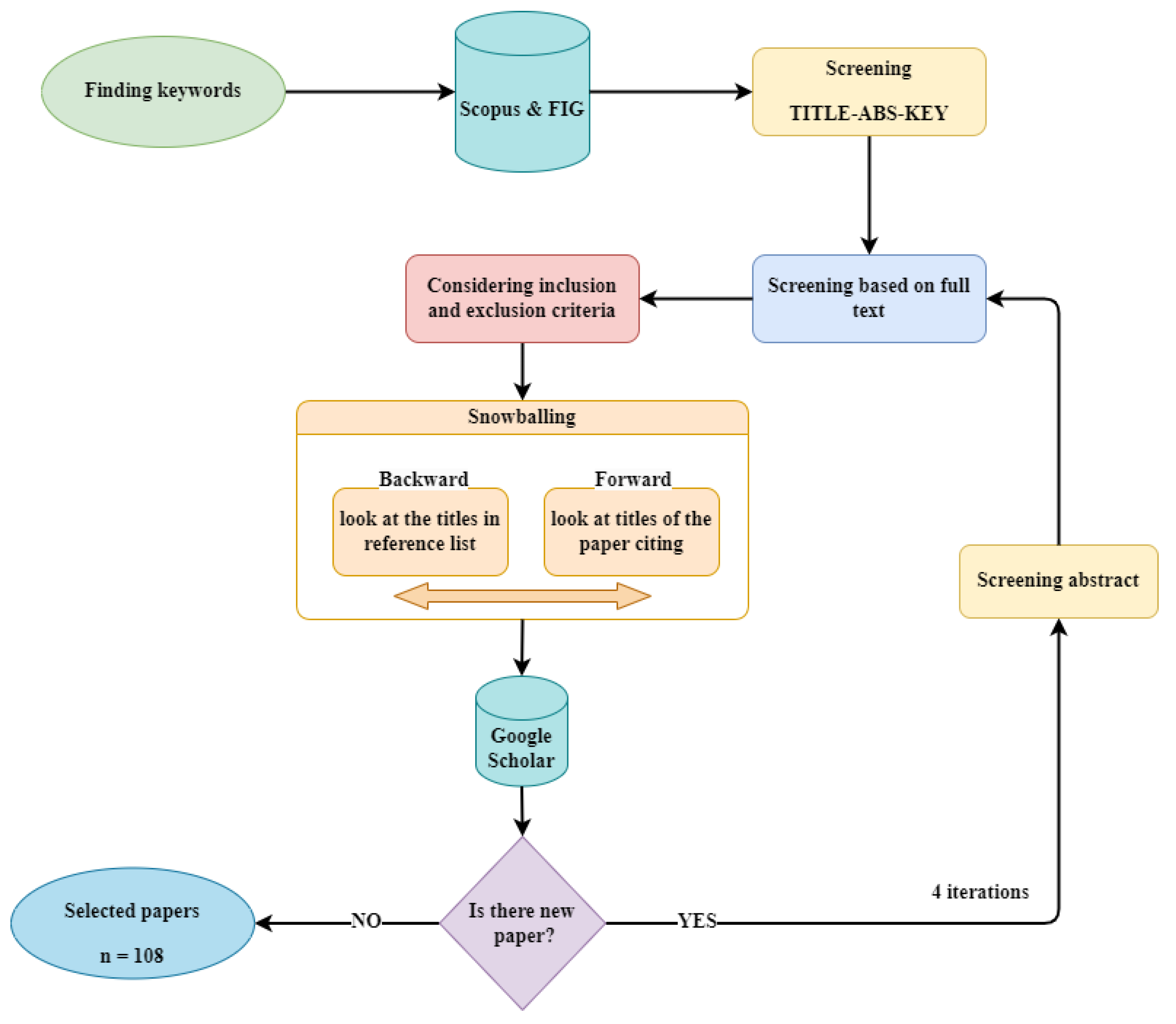
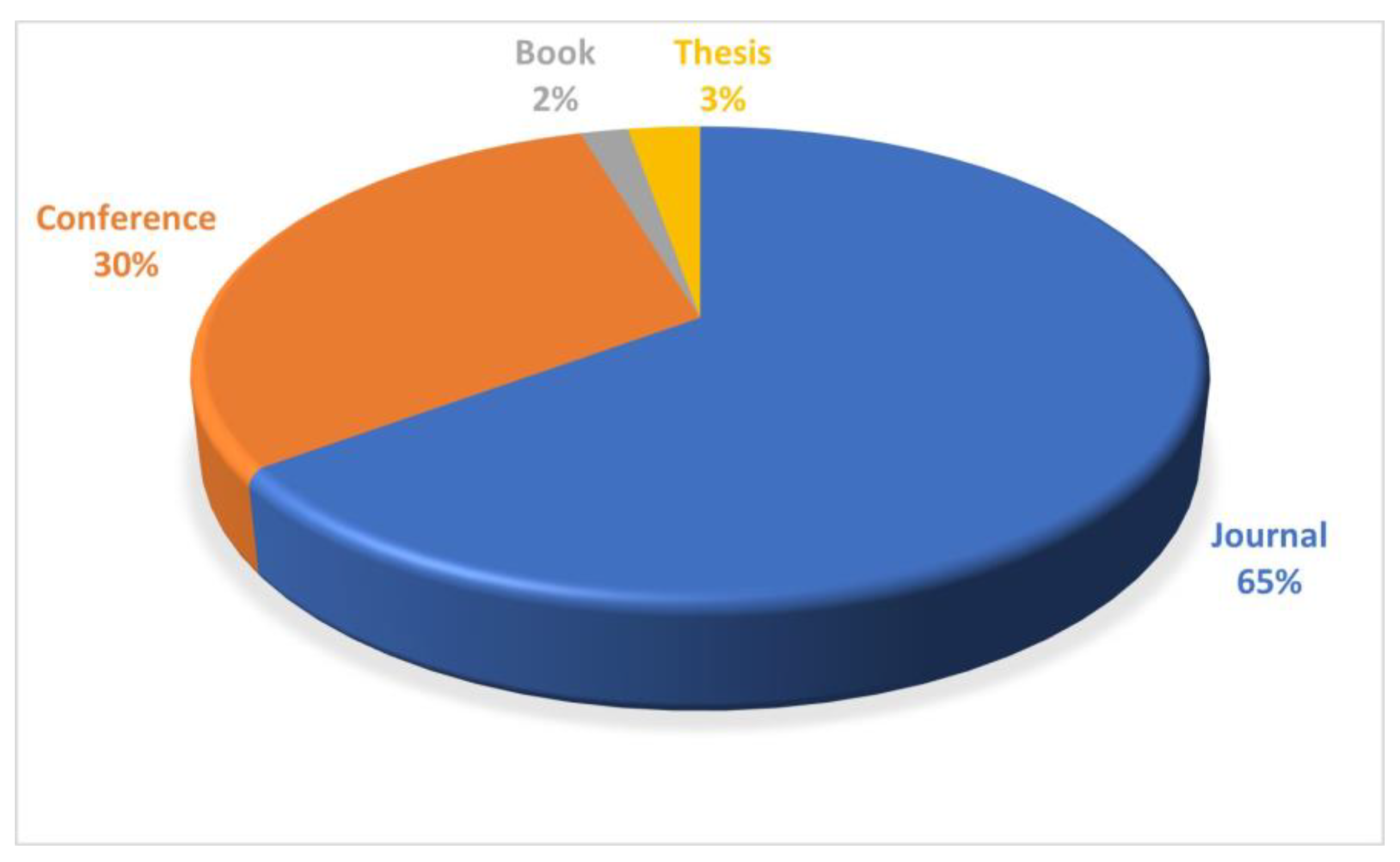
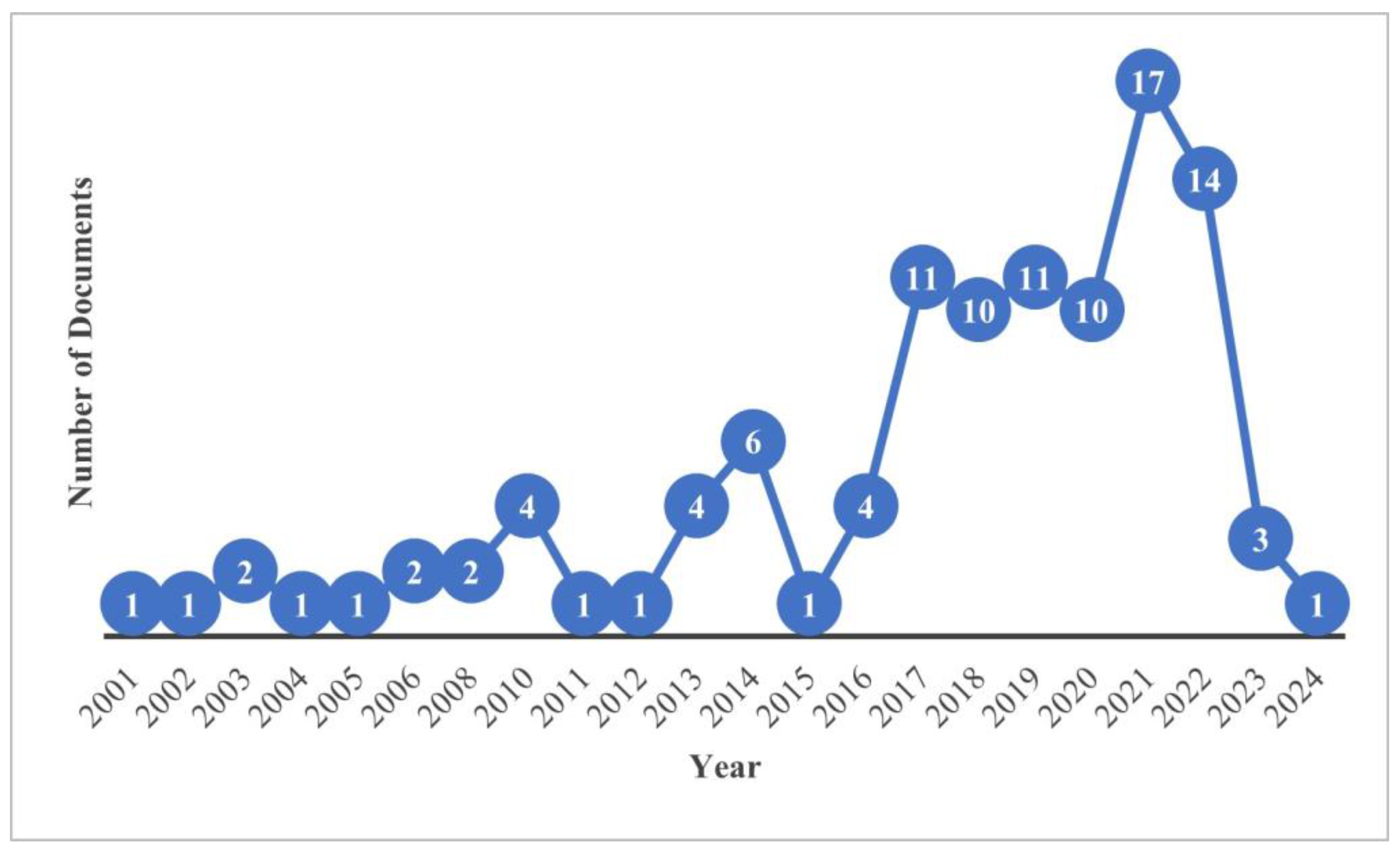
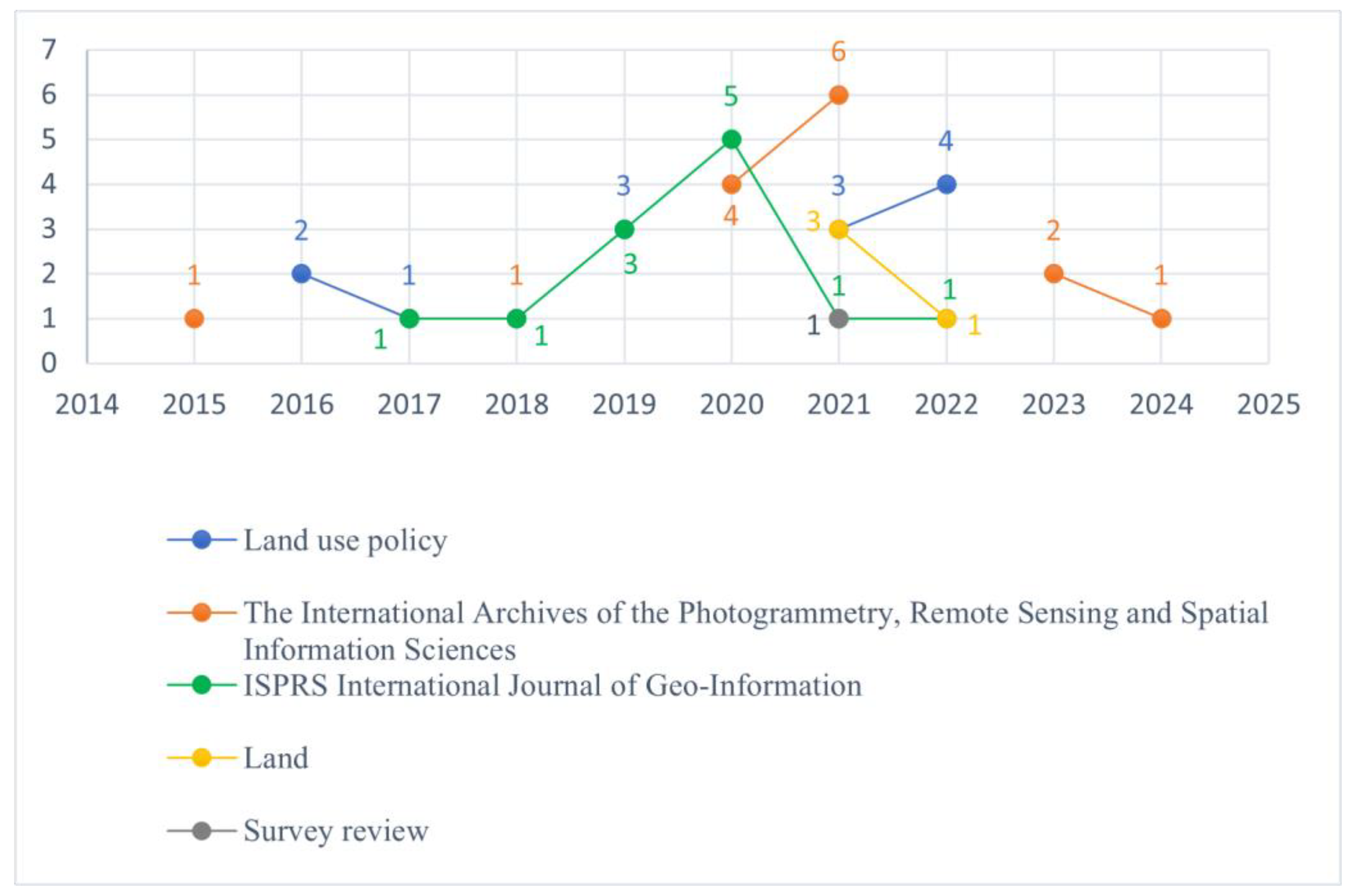
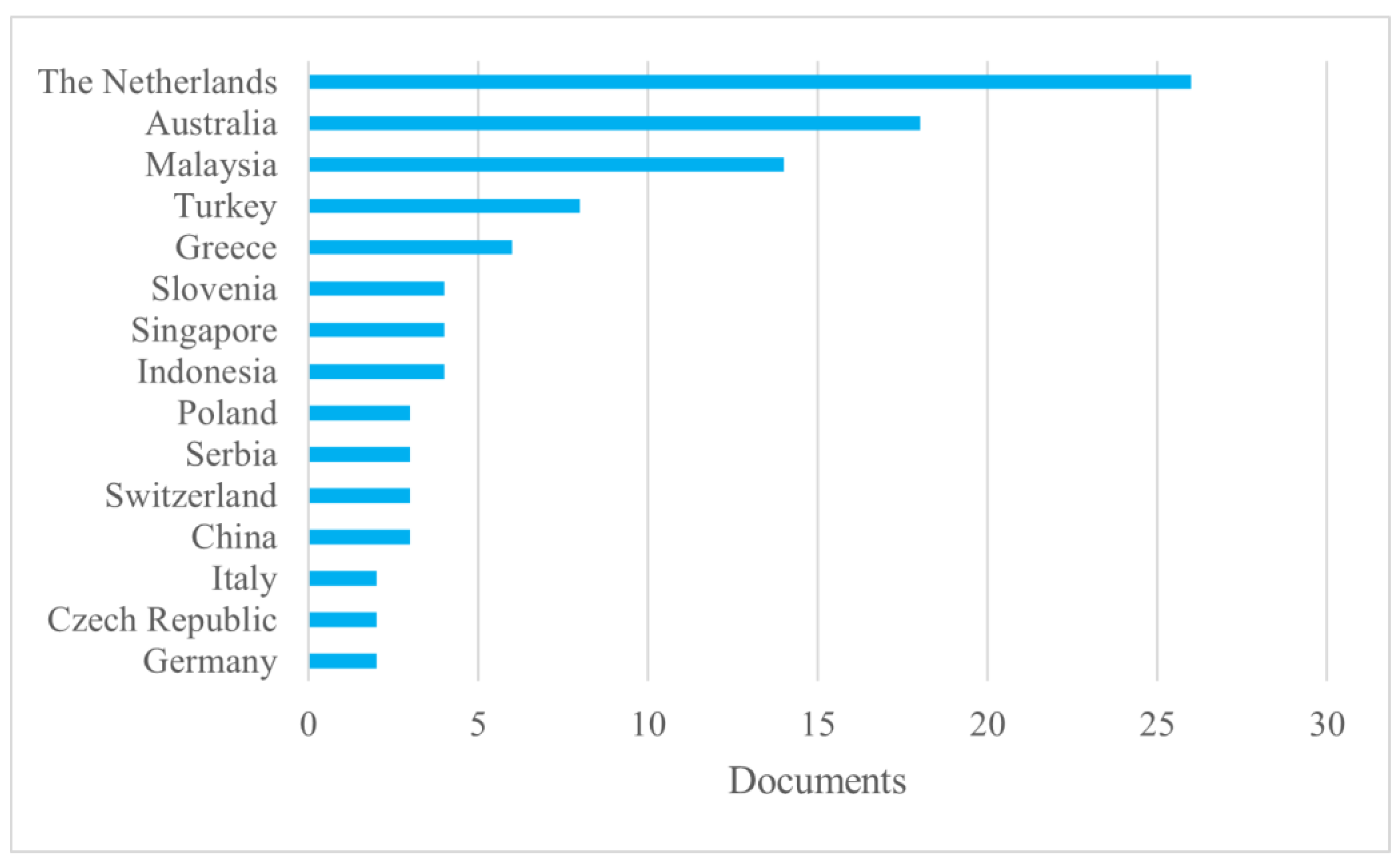
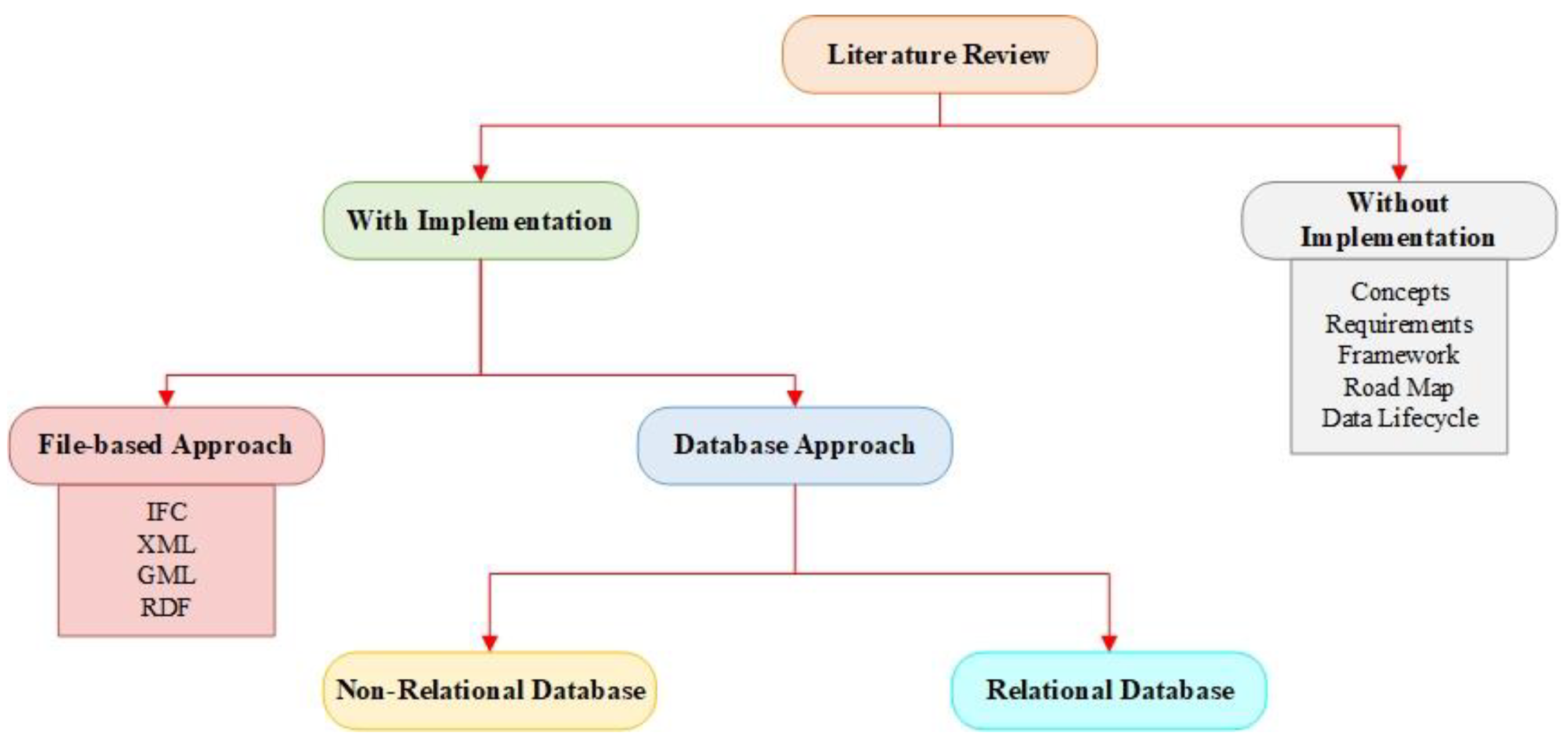

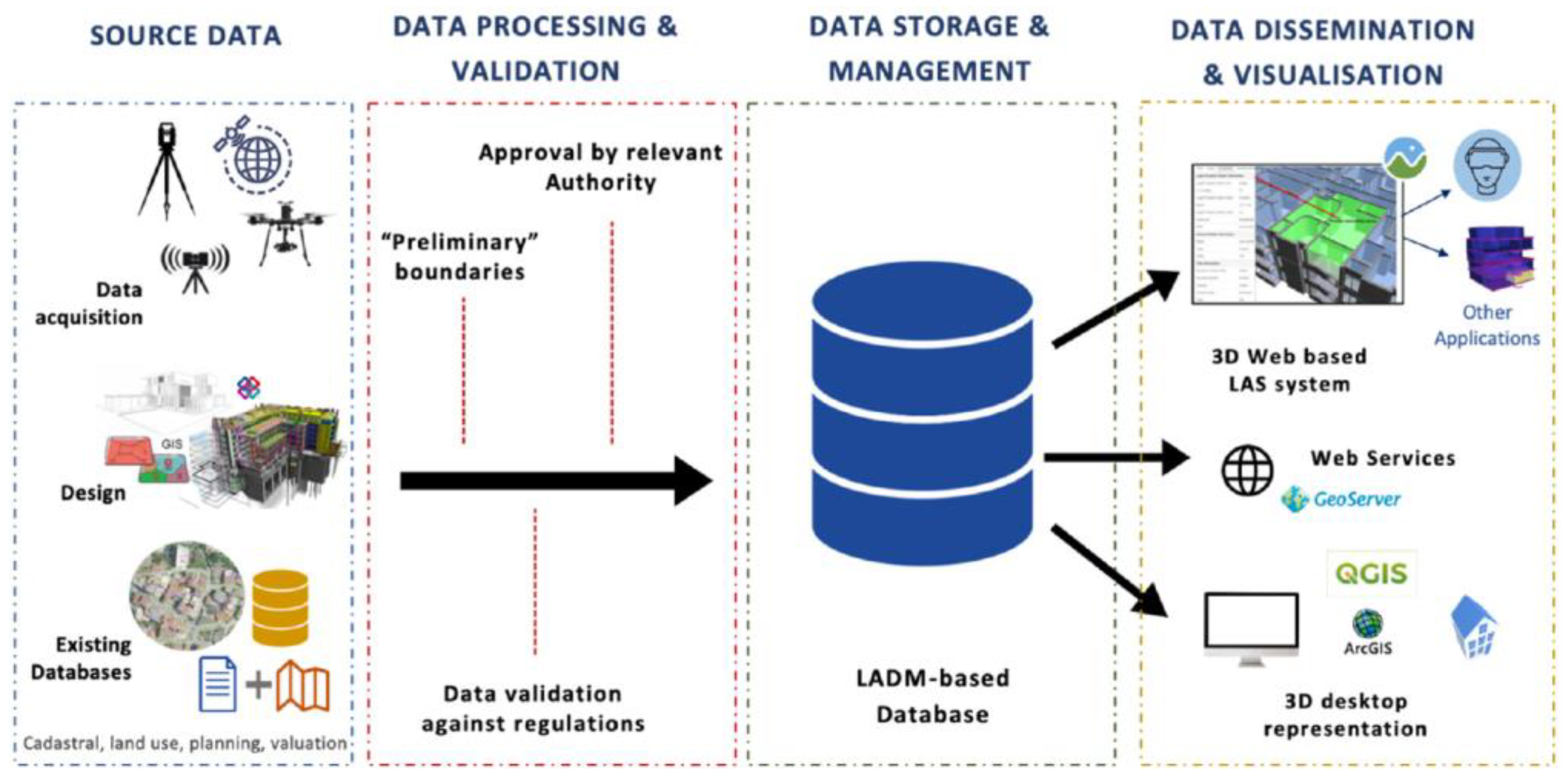
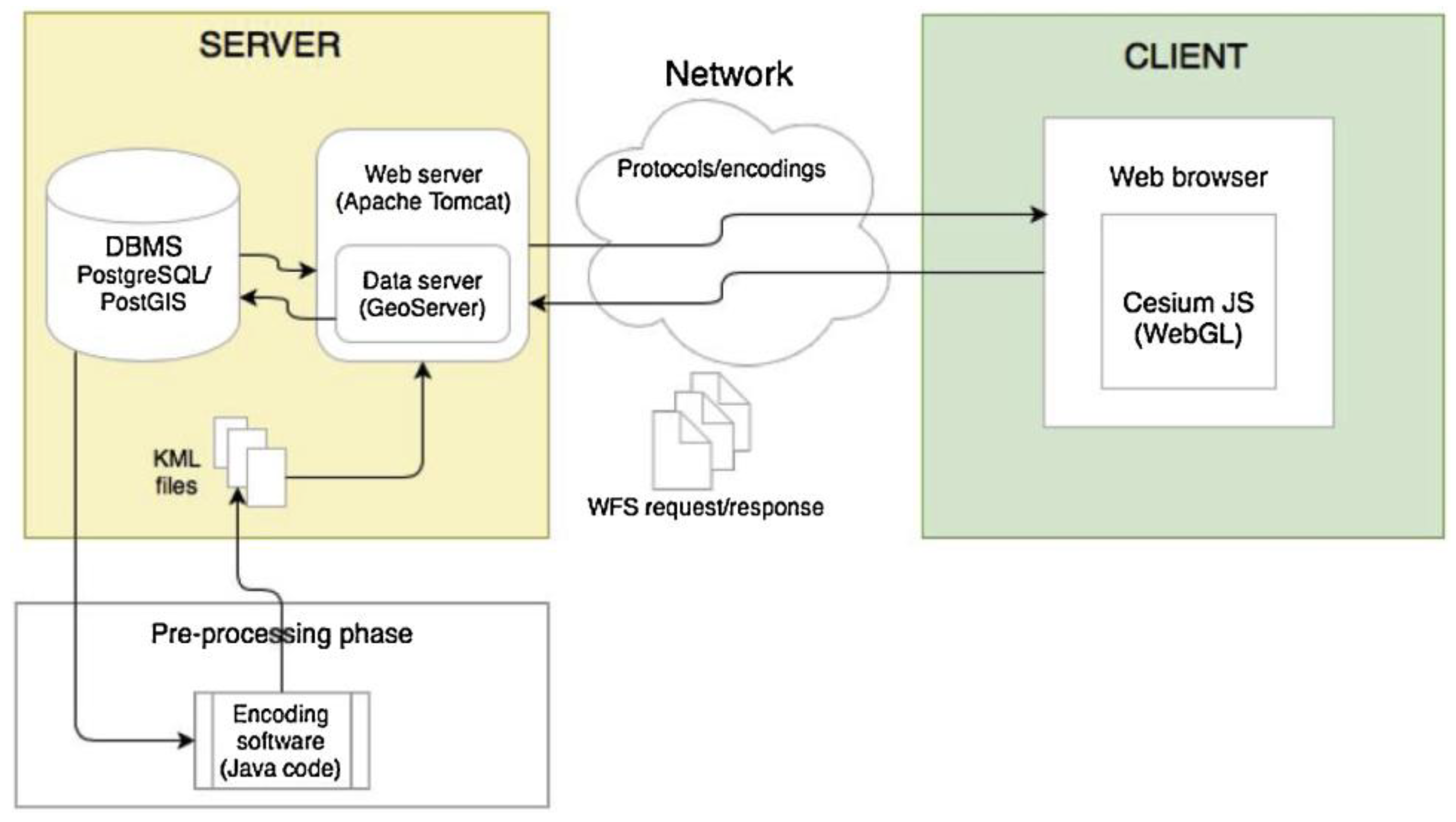
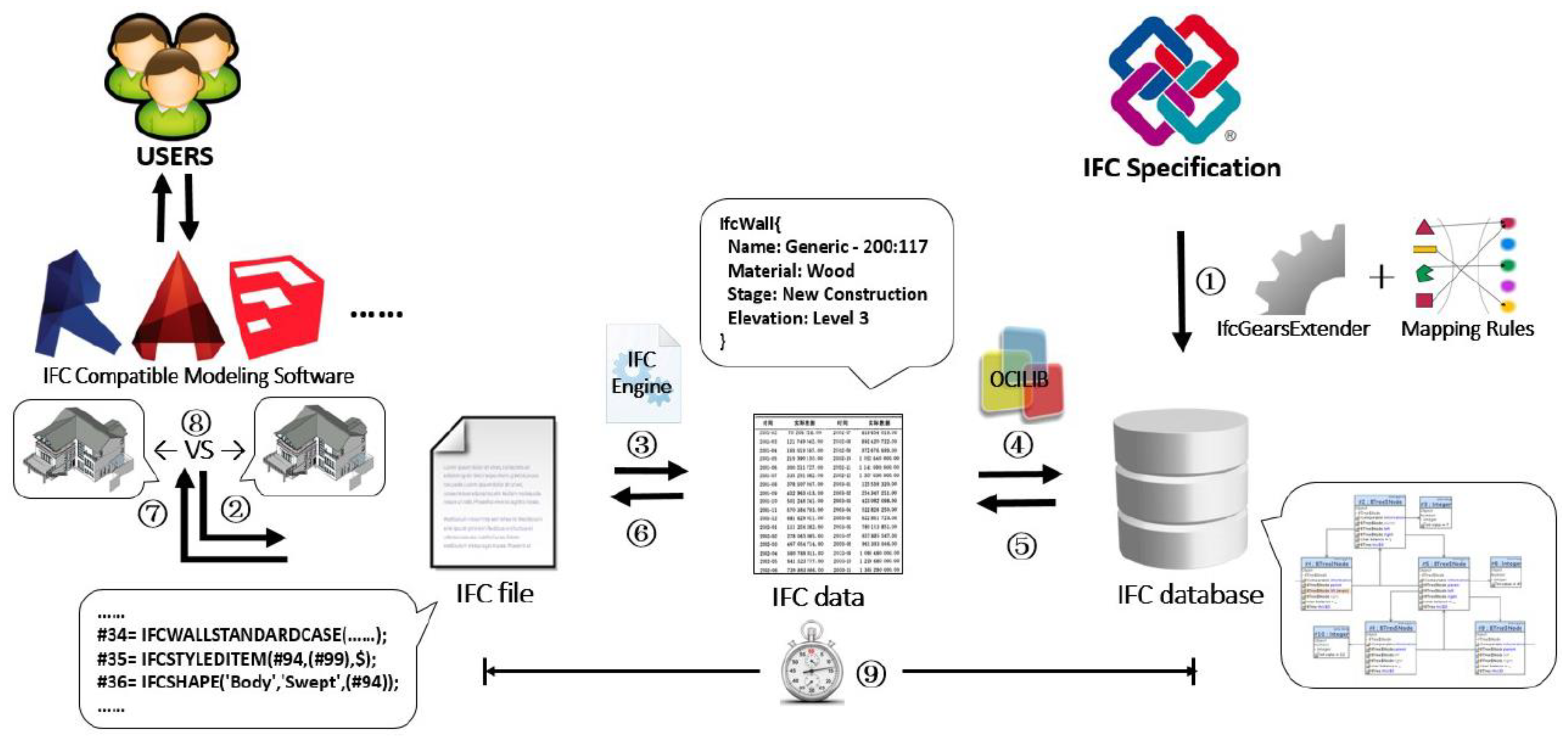
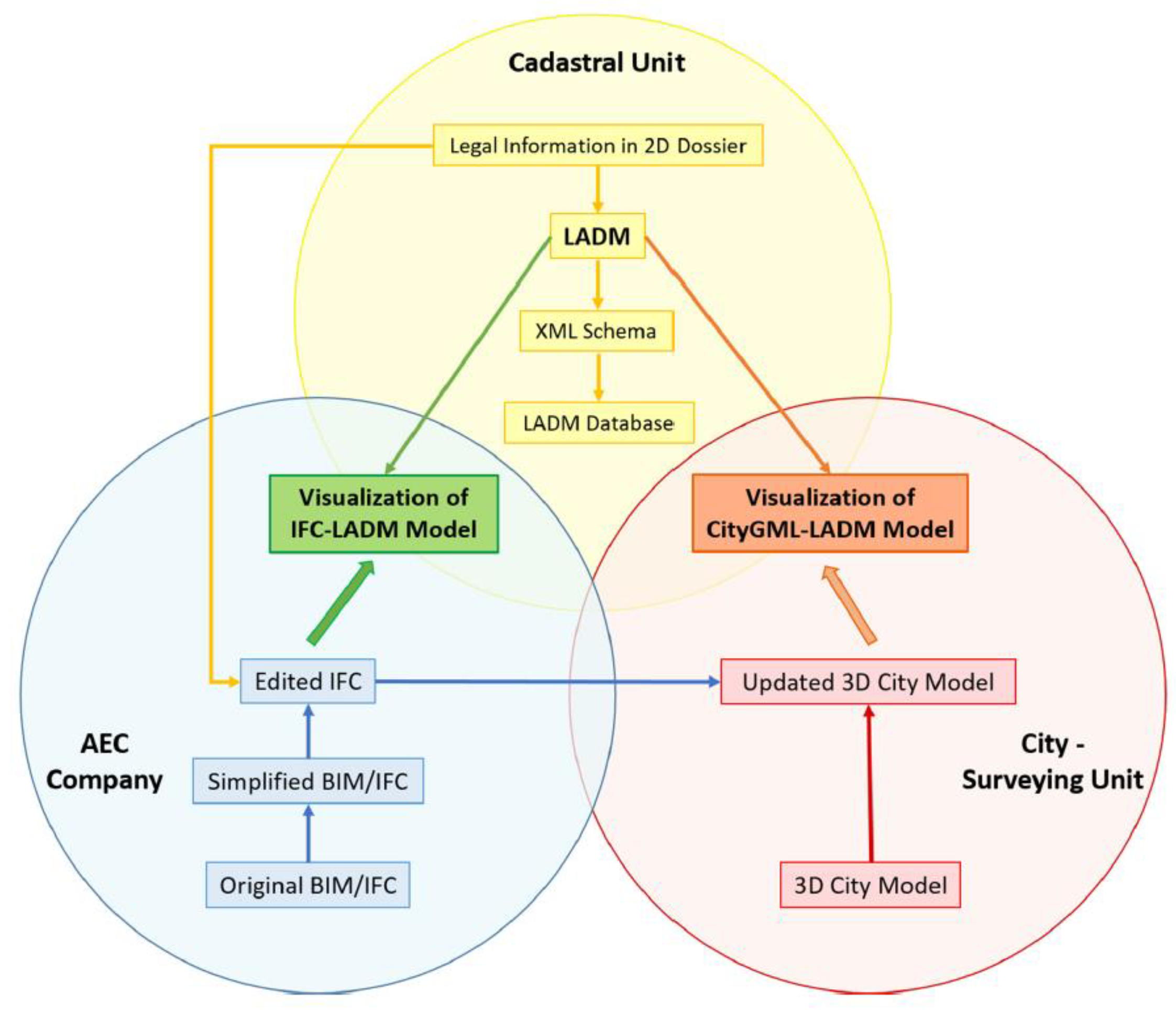


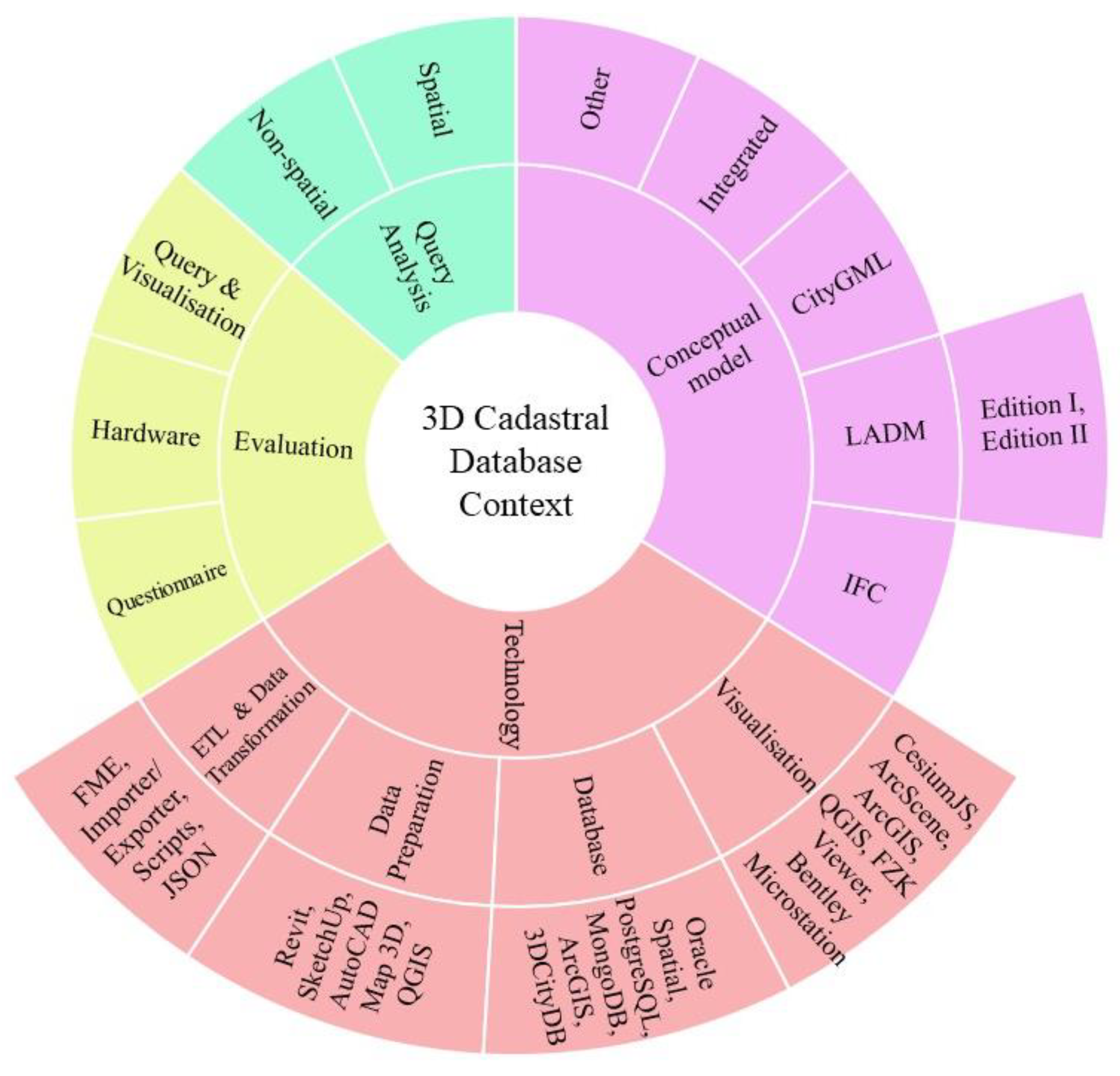
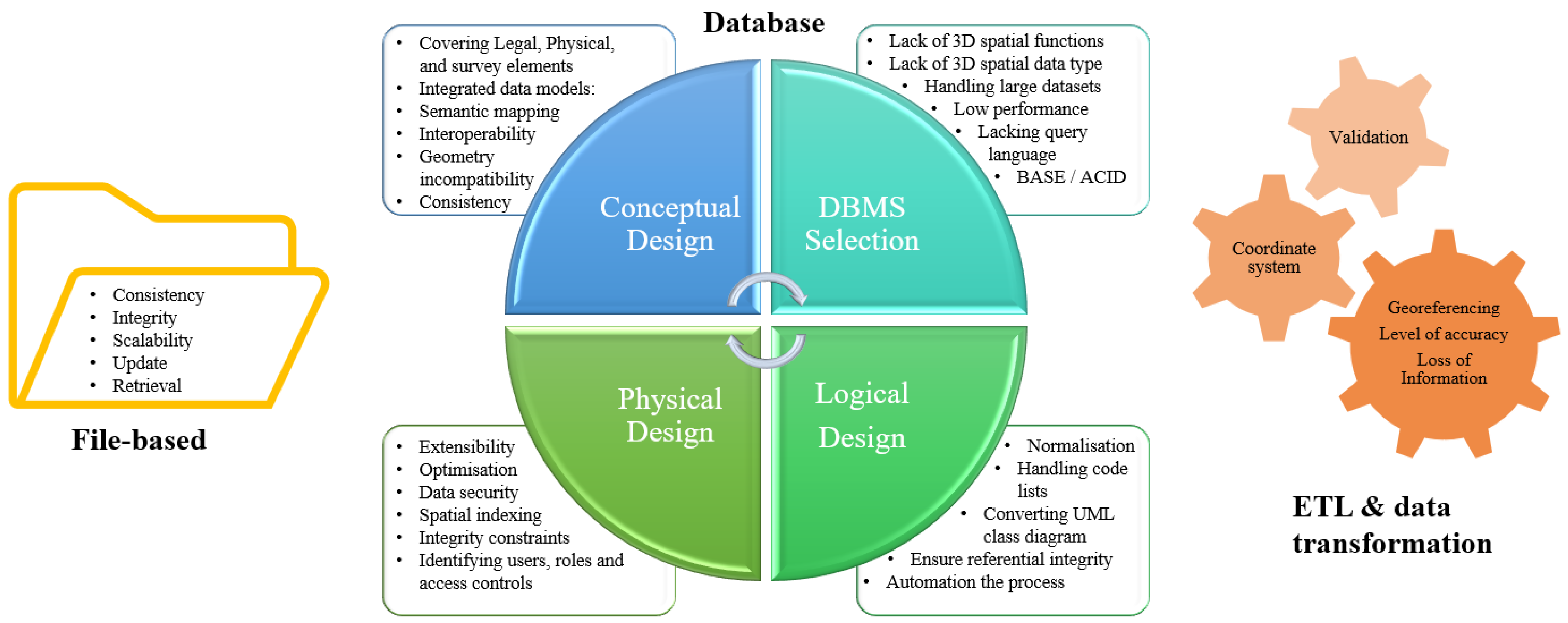
| Search within | Keywords/Operator |
|---|---|
| Article Title, Abstract, Keywords | cadastre OR “land administration” OR cadastral |
| AND | |
| Article Title, Abstract, Keywords | 3d OR “three-dimensional” OR 4d OR multidimensional OR “multi-dimensional” |
| AND | |
| Article Title, Abstract, Keywords | database OR “data base” OR dbms OR geodatabase OR file-based OR storage OR store OR query OR retrieve OR extract OR transfer OR integration OR conceptual OR logical OR physical OR querying OR storing |
| AND | |
| Language | English |
| Category | References | No. of Documents |
|---|---|---|
| Without implementation | [5,7,8,10,12,13,18,26,31,36,37,38,39,40,41,42,43,44,45,46,47,48,49,50,51,52,53] | 27 |
| Using database | [6,9,11,15,20,32,54,55,56,57,58,59,60,61,62,63,64,65,66,67,68,69,70,71,72,73,74,75,76,77,78,79,80,81,82,83,84,85,86,87,88,89,90,91,92,93,94,95,96,97,98,99,100,101,102] | 55 |
| Designing database | [1,25,27,28,29,30,103,104,105,106,107,108,109,110,111,112,113,114,115,116,117,118,119,120,121,122] | 26 |
| Reference | Conceptual Data Model | Data Preparation—ETL | Query Analysis | Evaluation | Technology |
|---|---|---|---|---|---|
| Gürsoy Sürmeneli et al. [55] | Integrated of LADM–CityGML | Importer/Exporter tool of 3DCityDB, Python code | Not used | Visualisation | 3DCityDB, PostgreSQL/PostGIS, GeoServer, CesiumJS |
| Gürsoy Sürmeneli et al. [57] | LADM | SQL commands | Non-spatial queries | Query | PostgreSQL/PostGIS |
| Da Purificação et al. [56] | LADM | Robo 3T | Not used | Visualisation | OMT-G Designer, Robo 3T, MongoDB, CesiumJS, MeshLab |
| Liamis et al. [113] | CityGML | Importer/Exporter of 3DCityDB | Not used | Hardware, Time processing | ArcGIS, Enterprise Architect, ShapeChange, FME, 3DCityDB, FZK, Google Earth Pro |
| Olfat et al. [15] | IFC | FME | Non-spatial queries | Query, Visualisation | Revit, FME, Oracle, CesiumJS |
| Barzegar et al. [76] | IFC | FME | Spatial and non-spatial queries | Query, Visualisation | Revit, Psycopg2 API, FME, PostgreSQL/PostGIS |
| Barzegar et al. [30] | IFC | FME | Spatial and non-spatial queries | Query, Visualisation | Revit, ArcGIS Pro, FME, PostgreSQL/PostGIS, Solibri AnyWhere |
| Rajabifard et al. [69] | LADM | QGIS | Non-spatial queries | Query, Visualisation | PostgreSQL/PostGIS, QGIS, GeoServer, CesiumJS |
| Van Bennekom-Minnema [111] | LADM II | GeoDjango ORM | Non-spatial queries | Query, Visualisation | Django/GeoDjango, PostgreSQL/PostGIS, Object-Relational Mapper (ORM) |
| Sammartano et al. [58] | Not used | Dynamo, ArcGIS Pro | Spatial and non-spatial queries | Visual Programming Language | ArcGIS Pro, Revit, Dynamo, EDISCO DB |
| Hajji et al. [70] | Integrated of CityGML-IFC | FME | Not used | Geometric validation, Semantic validation, Visualisation | Revit, FME, ArcGIS, FZK Viewer |
| Halim et al. [104] | CityGML | SketchUp, FME, Importer/Exporter of 3DCityDB | Non-spatial queries | Query | SketchUp, FME, 3DCityDB, CityDoctor, CityEditor, ArcGIS, PostgreSQL/PostGIS, QGIS |
| Tekavec et al. [61] | IFC | FME | Spatial queries | Hardware, time processing | FME, FZK Viewer, PostgreSQL/PostGIS, SFCGAL library, SketchUp |
| Cemellini et al. [60] | LADM | SQL commands, Encoding approaches | Spatial and non-spatial queries | Visualisation, Questionnaire | PostgreSQL/PostGIS, SQL, CesiumJS, Apache Tomcat, GeoServer |
| Višnjevac et al. [103] | LADM | Scripts in R, Exchange file formats | Non-spatial queries | Query, Visualisation | QGIS, MongoDB, NoSQL Viewer, CesiumJS, Rest API, JSONP |
| Li et al. [88] | Integrated of CityGML-IFC | Unclear | Spatial and non-spatial queries | Query, Visualisation | PostgreSQL/PostGIS, QGIS |
| Zulkifli et al. [105] | LADM | Mapfile | Not used | Query, Visualisation | PostgreSQL/PostGIS, Mapfile, QGIS, Enterprise Architect, C# NetCore, XSD, XDocument |
| Alattas et al. [27] | Integrated of LADM- IndoorGML | Not used | Not used | Not used | PostgreSQL/PostGIS, Enterprise Architect |
| Alattas et al. [28] | Integrated of LADM- IndoorGML | Revit, in-house ODBC | Non-spatial queries | Query, Visualisation | Revit, Open Database Connectivity (ODBC), PostgreSQL/PostGIS, Enterprise Architect |
| Kara et al. [98] | LADM | Manual (SQL commands) | Non-spatial queries | Query, Visualisation | Oracle Spatial, QGIS, Oracle SQL Developer Query Builder, Oracle SQL Developer, INTERLIS, Enterprise Architect |
| Kalogianni et al. [121] | LADM | Not used | Not used | Not used | INTERLIS, Enterprise Architect |
| Solihin et al. [79] | IFC | Unclear | Spatial and non-spatial queries | Query, Time processing, Visualisation | Oracle |
| Li et al. [80] | IFC | IFC Engine DLL, OCILIB | Non-spatial queries | Time analysis, Data model comparison | Revit, IFC Engine DLL, OCILIB, Oracle |
| Thompson [106] | LADM | Not used | Spatial and non-spatial queries | Query, Time processing, Visualisation | PostgreSQL/PostGIS, Google Earth, Web Map Server, |
| Mutiarasari et al. [107] | Not used | AutoCAD Map 3D, Google Earth, FWTools | Spatial queries | Query | AutoCAD Map 3D, Google Earth, FWTools, PostgreSQL/PostGIS, X3D, AutoCAD Map 3D |
| Zulkifli et al. [110] | LADM | Manual (SQL commands) | Non-spatial queries | Query, Visualisation | Oracle Spatial, Bentley MicroStation, Enterprise Architect |
| Zulkifli et al. [108] | LADM | Manual (SQL commands) | Non-spatial queries | Query, Visualisation | Oracle Spatial, Bentley MicroStation |
| Spirou-Sioula et al. [66] | Not used | Manual (SQL commands), Autodesk FDO Provider for Oracle | Not used | Visualisation | Oracle Spatial, ArcInfo, AutoCAD Map 3D, ArcGIS, ArcScene, ArcSDE, SketchUP, |
| Budisusanto et al. [109] | LADM | AutoCAD Map 3D, Google Earth, Autodesk 3DS Max, FWTools | Not used | Query, Visualisation | AutoCAD Map 3D, Google Earth, Autodesk 3DS Max, FWTools, PostgreSQL/PostGIS, Enterprise Architect, Delphi programming language/GLScene |
| Features | RDBMS | NoSQL |
|---|---|---|
| Data | Structured | Structured, Unstructured, Semi-Structured |
| Schema | Fixed | Dynamic |
| Scalability | Vertical | Horizontal |
| Compliance | ACID | BASE |
| Architecture | Centralized | Distributed |
| Consistency | Strict | Eventual |
| Query Language | SQL | OO API, SQL Like |
| Performance | Slow | Fast |
Disclaimer/Publisher’s Note: The statements, opinions and data contained in all publications are solely those of the individual author(s) and contributor(s) and not of MDPI and/or the editor(s). MDPI and/or the editor(s) disclaim responsibility for any injury to people or property resulting from any ideas, methods, instructions or products referred to in the content. |
© 2024 by the authors. Licensee MDPI, Basel, Switzerland. This article is an open access article distributed under the terms and conditions of the Creative Commons Attribution (CC BY) license (https://creativecommons.org/licenses/by/4.0/).
Share and Cite
Shahidinejad, J.; Kalantari, M.; Rajabifard, A. 3D Cadastral Database Systems—A Systematic Literature Review. ISPRS Int. J. Geo-Inf. 2024, 13, 30. https://doi.org/10.3390/ijgi13010030
Shahidinejad J, Kalantari M, Rajabifard A. 3D Cadastral Database Systems—A Systematic Literature Review. ISPRS International Journal of Geo-Information. 2024; 13(1):30. https://doi.org/10.3390/ijgi13010030
Chicago/Turabian StyleShahidinejad, Javad, Mohsen Kalantari, and Abbas Rajabifard. 2024. "3D Cadastral Database Systems—A Systematic Literature Review" ISPRS International Journal of Geo-Information 13, no. 1: 30. https://doi.org/10.3390/ijgi13010030
APA StyleShahidinejad, J., Kalantari, M., & Rajabifard, A. (2024). 3D Cadastral Database Systems—A Systematic Literature Review. ISPRS International Journal of Geo-Information, 13(1), 30. https://doi.org/10.3390/ijgi13010030








